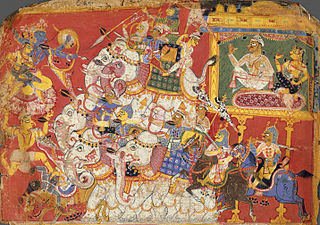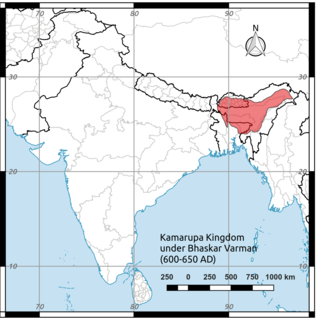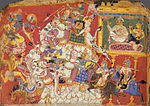
The Kamakhya Temple at Nilachal hills in Guwahati, Assam is one of the oldest and most revered centres of Tantric practices, dedicated to the goddess Kamakhya. The temple is the center of the Kulachara Tantra Marga and the site of the Ambubachi Mela, an annual festival that celebrates the menstruation of the goddess. Structurally, the temple is dated to the 8th-9th century with many subsequent rebuildings—and the final hybrid architecture defines a local style called Nilachal. It is also one among the oldest 4 of the 51 pithas in the Shakta tradition. An obscure place of worship for much of history it became an important pilgrimage destination, especially for those from Bengal, in the 19th century during colonial rule.
The Kalika Purana, also called the Kali Purana, Sati Purana or Kalika Tantra, is one of the eighteen minor Puranas (Upapurana) in the Shaktism tradition of Hinduism. The text was likely composed in Assam or Cooch Behar region of India and is attributed to the sage Markandeya. It exists in many versions, variously organized in 90 to 93 chapters. The surviving versions of the text are unusual in that they start abruptly and follow a format not found in either the major or minor Purana-genre mythical texts of Hinduism. Various types of animal sacrifices for devi are detailed in the Purana.

Kamarupa, an early state during the Classical period on the Indian subcontinent, was the first historical kingdom of Assam.

Naraka, also known as Narakasura, is an asura king in Hindu mythology. In Assamese tradition, he is regarded as the legendary progenitor of all three dynasties of Pragjyotisha-Kamarupa, and the founding ruler of the legendary Bhauma dynasty of Pragjyotisha. Though the myths about Naraka are first mentioned in the Mahabharata, later texts embellish them. According to later post-Vedic texts such as the Brahma Purana and Vishnu Purana, he was the son of Bhudevi, fathered either by the Varaha incarnation of Vishnu or Hiranyaksha. He is claimed as one who established Pragjyotisha. He was killed by Krishna and Satyabhama. His son Bhagadatta—of Mahabharata fame—succeeded him.

The history of Assam is the history of a confluence of people from the east, west, south and the north; the confluence of the Austroasiatic, Tibeto-Burman (Sino-Tibetan), Tai and Indo-Aryan cultures. Although invaded over the centuries, it was never a vassal or a colony to an external power until the third Burmese invasion in 1821, and, subsequently, the British ingress into Assam in 1824 during the First Anglo-Burmese War.

The Varman dynasty (350–650) was the first historical dynasty of the Kamarupa kingdom. It was established by Pushyavarman, a contemporary of Samudragupta. The earlier Varmans were subordinates of the Gupta Empire, but as the power of the Guptas waned, Mahendravarman (470–494) performed two horse sacrifices and the status of Kamarupa as an independent state remained unimpaired. As per the Apsad Inscription of Adityasen, Susthivarman was defeated by Mahasengupta on the bank of Lauhitya. The first of the three Kamarupa dynasties, the Varmans were followed by the Mlechchha and then the Pala dynasties.

The Mlechchha dynasty ruled Kamarupa from their capital at Harruppesvar in present-day Tezpur, Assam, after the fall of the Varman dynasty. According to historical records, there were twenty one rulers in this dynasty, but the line is obscure and names of some intervening rulers are not known. Like all other Kamarupa dynasties a semi-mythical lineage from Narakasura was constructed to accord legitimacy to their rule. The Mlechchha dynasty in Kamarupa was followed by the Pala kings. The dynasty is unrelated to the previous Varman dynasty.

The Pala dynasty of Kamarupa kingdom ruled from 900 CE. Like the Pala Empire of Bengal, the first ruler in this dynasty was elected, which probably explains the name of this dynasty "Pala". But unlike the Palas of Bengal, who were Buddhists, the Palas of Kamarupa were Hindus. The Hindu orthodoxy drew their lineage from the earlier Varman dynasty and thus ultimately from Narakasura i.e. Bhauma dynasty. The dynasty is unrelated to the previous Varman and Mlecchna dynasties.

The Bhauma dynasty is the second legendary dynasty of Pragjyotisha, after the Danava dynasty. Narakasura, who is said to have established this dynasty, and his descendants Bhagadatta and Vajradatta are first mentioned in the epics Mahabharata and the Ramayana in the sections that were composed in the first few centuries though they place them variously in either northwestern or eastern India. Narakasura's legend is further embellished in the locally composed Kalika Purana, the Yogini Tantra and local lores and the legends became firmly attached to Assam and North Bengal. The late embellishment of the Naraka legends point to legitimization of the three dynasties of the Kamarupa kings.

Bhagadatta was the son of Narakasura, and the king of Pragjyotisha in Hindu mythology. Bhagadatta was born from a limb of the asura called Bashkala. He was a renowned warrior, and was known to be a great friend of Indra. When Arjuna embarked on a conquest to help his brother Yudhishthira perform the rajasuya yajna, Bhagadatta was one of the first kings to be conquered by him.

Bhaskaravarman was king of medieval Kamarupa and the last of the Varman dynasty. After being captured by the Gauda king during the reign of his father, he was able to re-establish the rule of the Varmans. He made political alliances with Harshavardhana of Thaneswar, against the alliance of the Gauda and East Malwa. He was visited by Xuanzang and Wang Xuance, the envoys of the Tang dynasty who have left accounts of the king and the kingdom.

The earliest Indo-Aryan migration to Assam is estimated to have occurred between the 2nd century BCE and 1st century CE—not earlier than 500 BCE. The earliest epigraphic record suggests that the Indo-Aryan migration began latest by the middle of the 4th century CE. They came from the Gangetic Plains into a region already inhabited by people who spoke Austroasiatic and Tibeto-Burman languages.

Pragjyotishpura or Pragjyotisapura, now deemed to be a region within modern Guwahati, was an ancient city and capital of the Varman dynasty. Though the earliest mention of Pragjyotisha in local sources come from the 7th century, the form was changed to Pragjyotishpura in the 9th century which describes it as the city of Naraka within Kamarupa. In Puranic text like the Ramayana, Pragjyotishpura is described as the fortress of Narakasura on mount Varaha located in the north-west of the Indian subcontinent in what is modern-day Punjab and Sindh.

Kamarupa – Late to end period was a period of Kamarupa kingdom from founding of Pala Dynasty by Brahma Pala to last ruler of dynasty Jaya Pala.

Kamrup is the modern region situated between two rivers, the Manas and the Barnadi in Western Assam, with the same territorial extent as the Colonial and post-Colonial "Undivided Kamrup district". It was the capital region of two of the three dynasties of Kamarupa and Guwahati, the current political center of Assam, is situated here. It is characterized by its cultural artifacts.

Kamarupa Pithas are ancient pithas or geographical divisions of Kamarupa. The division of the Pithas are not consistent in different sources, though the number of pithas are usually four. Since these pithas are not mentioned in the Kamarupa inscriptions, and are found mentioned only in later medieval texts some authors have suggested that these divisions are possible later fabrications. The Yogini Tantra, mentions the Kamarupa Pithas, the same work which gives boundaries of ancient Kamrup kingdom as well.

Vajradatta is an asura king in Hindu mythology. He is the son and successor of King Bhagadatta, and the third ruler of the Naraka dynasty of the Pragjyotisha Kingdom. Vajradatta is regarded to have studied the four Vedas along with the discplines called the Angas, as well as the Nitishastras of Brihaspati and Shukra. Vajradatta is mentioned in epics as powerful as Indra, speedy like Vajra and who pleased the performer of hundred sacrifices, who is Indra again, in battle. He said to possess bolt-like lustre and conquered enemies like Indra.

Asura Kingdom is a mythological kingdom that is mentioned in a multiple of Hindu epics which later came to be associated with modern-day Tezpur in central Assam and Banasura Hill in Kerala. The kingdom was contemporary of Pragjyotisha. In Puranic literature, Pragjyotisha and Sonitpura were located to the northwest of the Indian subcontinent in what is modern-day Punjab and Sindh. In Assam, the name of the legendary kingdom might be applied to the local inhabitants who were outside of the Hindu fold. In Kalika purana, Banasura, the last ruler of the asura kingdom is represented as an anti-Brahminical character.

Assamese Brahmins are the Brahmins present in the Assamese society. There they promoted learning, Vedic religion, astrology, ayurveda and as well as imparting general vedic knowledge to the public. The Brahmins migrated to Assam from Videha (Mithila), Kannauj, Bengal and many other places.










